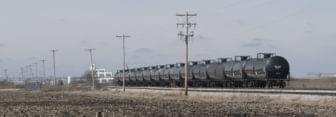Delays At Proposed Illinois Fertilizer Plant Put Tax Breaks At Risk

The proposed Cronus site on the north side of the highway on March 21, 2016. Darrell Hoemann/Midwest Center for Investigative Reporting
Cronus Chemicals will start losing part of its nearly $40 million in state tax incentives if its proposed $1.9 billion ammonia fertilizer plant in Tuscola, Ill., is not operating by July 2, according to tax credit agreements.
A review of company filings with the state of Illinois shows the project must be “in service” within 24 months of July 2, 2015. According to the documents, “in service” means “the state or condition of readiness and availability for specifically assigned functions.”
And if the plant is not complete and operating within five years of July 2, 2015, the company will lose out on all $40 million of its tax incentives from the Illinois Department of Commerce, said department spokeswoman Jacquelyn Reineke.
Construction beginning this year would put the opening of the plant in 2020, around the same time the credits would expire if the plant is not operational. An opening in 2020 is several years behind the company’s original schedule and the schedule Cronus gave the state as recently as last summer.
At this point, the 37-month project is at least three and a half years from completion, as the soonest a groundbreaking would happen would be this summer, said Brian Moody, the executive director of Tuscola Economic Development, Inc. who helped bring Cronus to Tuscola.
Last year, the company quietly announced on its website that the plant’s cost had increased to $1.9 billion and that it would not be operating until late 2019.
Cronus originally had a price tag of $1.4 billion with a completion date of early 2017, when then-Gov. Pat Quinn announced Tuscola as the site for the plant in November 2014. The announcement came just days before the gubernatorial election.
An empty field
Currently, the plant site remains an empty field and little preparatory work has been done. Cronus signed a contract with the Urbana Champaign Sanitary District to supply wastewater to the plant in March 2014. The contracts call for at least $2 million of wastewater a year to be sold to Cronus once it’s operational.
The plant could be eligible for tax credit extensions, though it would have to be approved by the administration of Republican Gov. Bruce Rauner, who defeated Quinn in 2014.
Cronus is managed by a group of four people who operate out of a shared office in Chicago. The group includes two foreign investors with ties to the global fertilizer industry.

A train near the field that will become the Cronus plant east of Tuscola on March 4, 2016.
The CEO, Erzin Atac, is a Swiss citizen, who has worked in fertilizer for more than 30 years. Another partner, Seref Surmen, is a Turkish citizen and the majority owner of the Nokta Yatirim Holdings company, which owns other fertilizer companies across the world.
Calls to the company’s headquarters went unreturned, and a receptionist for Cronus said that the company has a devoted office space, but executives do not have set hours when they are in the office.
While there are not regular hours, meetings with Cronus continue for Tuscola staff, with the most recent happening on Feb. 28 in Champaign.
Atac could not be reached for comment, but Dave Lundy, a spokesman for the company, said the cost of plant remains $1.9 billion, and the project is supposed to begin construction sometime this year. He said construction is still expected to take roughly three years.
“The incentives remain important to the project, and we will engage with state officials to deal with the revised timeline,” Lundy said.
During the 2014 announcement, Quinn said Cronus would receive about $52 million in incentives to come to Tuscola.
The breakdown of the $51.5 million in tax incentives and state support includes:
- $35 million through a “High Impact Business” designation that eliminates several taxes, including sales tax on materials used in construction and a tax on natural gas
- $12.6 million in infrastructure funding from the Illinois Department of Transportation
- $3.9 million in an abatement on state income tax through the Economic Development for Growing Economy (EDGE) tax credit, according to a news release when the project was announced.
The EDGE tax credit program, a tool used by the state to give companies tax abatements for hiring or retaining employees Illinois, has since expired, though Cronus’ current agreement has been grandfathered in, Reineke said.
The funds from the Illinois Department of Transportation do not have an expiration date, and they are in the state’s five-year plan, said Douglas County Engineer James Crane.
“Ultimately, if it goes too much farther down the road, the money will probably disappear, but we’re OK for right now,” Crane said.
In addition, it is likely that the plant will receive property tax abatements, which will be up to 50 percent of its property tax bill, Moody said.
Inconsistencies in state tax forms
To receive the incentives, the company must file annual project progress reports with the state.
While the number of employees to be hired is consistent on both required tax credit applications and reports, the start dates are inconsistent.
In its most recent filing from June 2016 on the EDGE credit, Cronus said it would begin hiring 130 employees in Tuscola in October 2017, with a total annual compensation of $8 million.
But in a report filed for the High Impact Business credit one day earlier — on June 8, 2016 — Cronus told the state it would hire its 130 employees in Tuscola by October 1, 2016. But there is no record of employees being hired.
Cronus reported the same start date of Oct. 1, 2017 for the new employees in its original EDGE tax credit application filed in 2014 and on its report in 2015.
But, for its High Impact Business credit application in 2014 and on its 2015 report, Cronus reported a start date of Oct. 1, 2016.
When asked whether employees will be hired this year, Lundy replied in an email that construction project employees are expected to be hired but did not address plans for full-time employees.
Lundy himself is not an employee of Cronus; he serves as president of Aileron Communications, a Chicago public relations firm.
The firm represents many high-profile clients, including the foundation of J.B. Pritzker, a Chicago billionaire who media reports mention as a potential candidate for governor.
Cronus Chemicals also received an EDGE tax credit for its headquarters in Chicago, where it said it will make a $3.8 million capital investment at its facility in Chicago and hire 27 full-time jobs.
Those 27 employees were supposed to be hired in the first two years of the project but there is no record of any hires. The most recent update said the employees, with a total annual compensation of $5.6 million, would start on July 1, 2017.
In the agreement, the company agreed to purchase $40,000 worth of office equipment and machinery, $383,794 worth of lease hold improvement and $4,009,125 worth of lease payments for 10 years, discounted at 3 percent for a net present value of $3,368,376.
But while the company has promised to spend $4 million in office space leases in Chicago, it currently leases a suite in a shared office space that can be rented for as low as $72 per month – or less than a $1,000 per year.
The company’s Chicago headquarters is housed at 150 N. Michigan Ave, Suite 2800, Chicago, IL.
That address is a shared space for a variety of companies that can be rented for as low as $72 per month for a customized phone answering system or $89 per month for the ability to use the address for mailing. Other packages that include conference room time are $249 per month or $403 per month.
Other companies leasing the same suite include law firms, investment firms, a doctor’s office, a custom men’s clothing shop and a security consulting business., according to company listings.
The documents also show the Cronus plant would create 130 permanent jobs in Tuscola — not the 175 to 200 jobs officials touted when first announced in 2014.
In addition, in its initial application for state tax credits, company officials said the project would have a minimum cost of $450 million — almost $1 billion less than originally publicized on its website.
In that application, the company’s submitted timeline projected that it would purchase $10 million of land in 2016 and $440 worth of construction in 2017, with commissioning of the plant to take place in 2018.
Lundy said the employment numbers and investment cost filed with the state were a minimum target and not reflective of the actual project numbers.
Lundy said the agreement was for a minimum investment and that the total cost was still $1.9 billion but did not respond to a request for a breakdown of that number.
“Schedules on complex projects can vary depending upon many circumstances,” Lundy said.
Contract among final steps before start of construction
The company is finalizing deals with its master contractors, said Moody, though the company had announced it had reached contracts for the project in December 2014, February 2015 and March 2016.
Cronus has made some changes to its contracts, and he expects the contracts will be completed by the end of the first quarter of 2017, Moody said.

Brian Moody, the executive director of the Tuscola Economic Development Inc., lays out the plan for the Cronus plant on January 20.
“Getting to that milestone is the same milestone we’ve been waiting for — for a year plus,” said Moody. “That happening would start to line up some dates. … That would probably take us into a late summer timeline for potentially having a groundbreaking type of thing.”
Moody said the county will start the bidding process on roadwork once they get the go-ahead from Cronus.
“The county gets a little bit of lead time,” he said. “They can start roadwork and start having heavy equipment that goes in after that.”
Crane said he expects the roadwork to start in the spring of 2018.
Moody said he is confident the project will happen.
“Cronus has been very clear that the second they felt like the project was in jeopardy, something is going to go wrong, they’ve been out here to tell us,” he said. “There haven’t been any kind of big negative issues or anything that has blown up (to delay the project). I keep telling people here it’s an incredibly tough thing to pull off what will probably be a close to $2 billion project by the time it’s all said and done.”
Cronus among wave of new plants, many delayed
The Cronus plant is part of a wave of fertilizer projects over the past four years – many of which have been delayed or cancelled.
Still it is one of three projects in North America that seems to be the most likely to be constructed, according to a September 2016 market analysis by Stamicarbon CEO Pejman Djavdan at the Gulf Petrochemicals and Chemicals Association Fertilizer Convention. Stamicarbon is the world leader in licensing urea technology, and its clients include Cronus.
Across the country, the ammonia fertilizer production capacity has increased 42.1 percent since 2014, according to AmmoniaIndustry.com, which tracks construction nationwide.

The future site of the Cronus fertilizer plant on March 4, 2016.
The increase in capacity and lower natural gas prices has pushed the price of fertilizer down, with Illinois farmers now paying $80 less for fertilizer per acre than they were in 2013.
Currently, there are 28 operating ammonia fertilizer plants in the United States with a capacity of 17.5 million metric tons per year.
In 2014, there were 24 plants that produced 12.3 million metric tons per year. Many of those plants have since expanded. Cronus’ production, for example, is expected to be 923,500 metric tons per year.
This increase has been driven by the shale gas boom, which caused natural gas prices to drop, and high agriculture profits that gave farmers more money to spend, according to Djavdan’s market analysis.
The analysis states “producers margins, increased from 11 percent in 2000 to almost 50 percent late 2014 on the back of Midwest (premium) nitrogen prices and low feedstock cost.”
The expansion has been accompanied by a number of projects that were announced but not completed.
Since 2013, 14 proposed plants with a capacity of 5.7 million metric tons per year have been canceled, according to AmmoniaIndustry.com.
Another 32 projects — new plants, plant restarts and expansions — are in the works that would increase production capacity by 16.8 million metric tons per year, according to AmmoniaIndustry.com.
Only seven of those projects are considered likely, 13 are considered possible (including Cronus), and 12 are considered unlikely.
All of the “likely” projects are expected to start production in 2017. The possible and unlikely projects are still in the planning and financing stages.
Unlike AmmoniaIndustry, which focuses on all projects, Djavdan’s analysis focused on new large-scale projects, of which he said there are more like six large-scale plants in the works, but there is likely no need for six new plants.
Instead, there is room for at least two major projects in North America, according to the analysis.
Cronus is one of three projects, along with the also-delayed Midwest Fertilizer project in Mount Vernon, Indiana, and another plant being explored in Quebec, that seem to be the most likely to fill that void.
Of the remaining three, two are currently “on hold,” and one was recently canceled.
These projects have been delayed largely because of increased engineering costs, a dependence on debt financing and short-term low urea prices, Djavdan said.
The projects that have been completed have been funded by corporate finance, which means that companies show lenders they have the capital to pay off a loan if the project fails.
Many of the other projects — like Cronus — that have been delayed or canceled depended on project finance, meaning the profits from the plant would be used to repay lenders, and the people behind the project don’t have the assets to cover the project otherwise, the analysis found.
Tuscola waits again for billion-dollar project
The Cronus Fertilizer plant is the third billion-dollar project considered for Tuscola in the past 12 years.
The first two — FutureGen and GreatPoint Energy — were both explored before ultimately being moved elsewhere and then canceled. Tuscola was considered because it is has three major natural gas pipelines near the city, in addition to multiple railroads.
“We’ve spent considerable time and effort working on these,” Moody said. “These were efforts that were very successful as far as what we needed to accomplish on our end, but that ultimately didn’t happen.”
I teach some economic development classes, and I don’t advise communities to do what we have done.”Brian Moody, City of Tuscola
Moody said he understands that completing projects of this size take a lot to happen.
“That’s what happens with a lot of these companies,” Moody said. “There’s a good idea out there, a lot of people recognize it as a good idea, and everybody jumps into the market to see if they can do it.”
That means a lot of these projects don’t happen, but when they don’t, it leaves places like Tuscola holding the bag, Moody said.
Moody said, while he’s hopeful Cronus will happen, it’s clear that going after large-scale industrial projects is not a winning strategy for most towns.
“I go off, and I teach some economic development classes and I don’t advise communities to do what we have done,” Moody said. “It’s a risky business around the country given that there’s only about 200 large projects that happen in a given good year and for a community of our size it’s very difficult to recruit those types of projects.”
Links
- Cronus Makes Tuscola Plant Official
- Cronus Chemicals Coming To Tuscola
- Illinois Issues Draft Of Cronus Plant Permit
- Cronus Chemical Delays Decision On Plant Location
- Geologist Rob Finley Talks About FutureGen
- Department of Energy Faces Push Back After Cancelling FutureGen
- Department Of Energy Suspends FutureGen
- EPA OKs FutureGen Permits
- Ameren Ending Partnership in FutureGen Project
- FutureGen Hearings Planned for June
- Morgan County Chosen Over Douglas and 2 Others For FutureGen Storage Site
- Western Illinois Site Gets FutureGen Storage Facility
